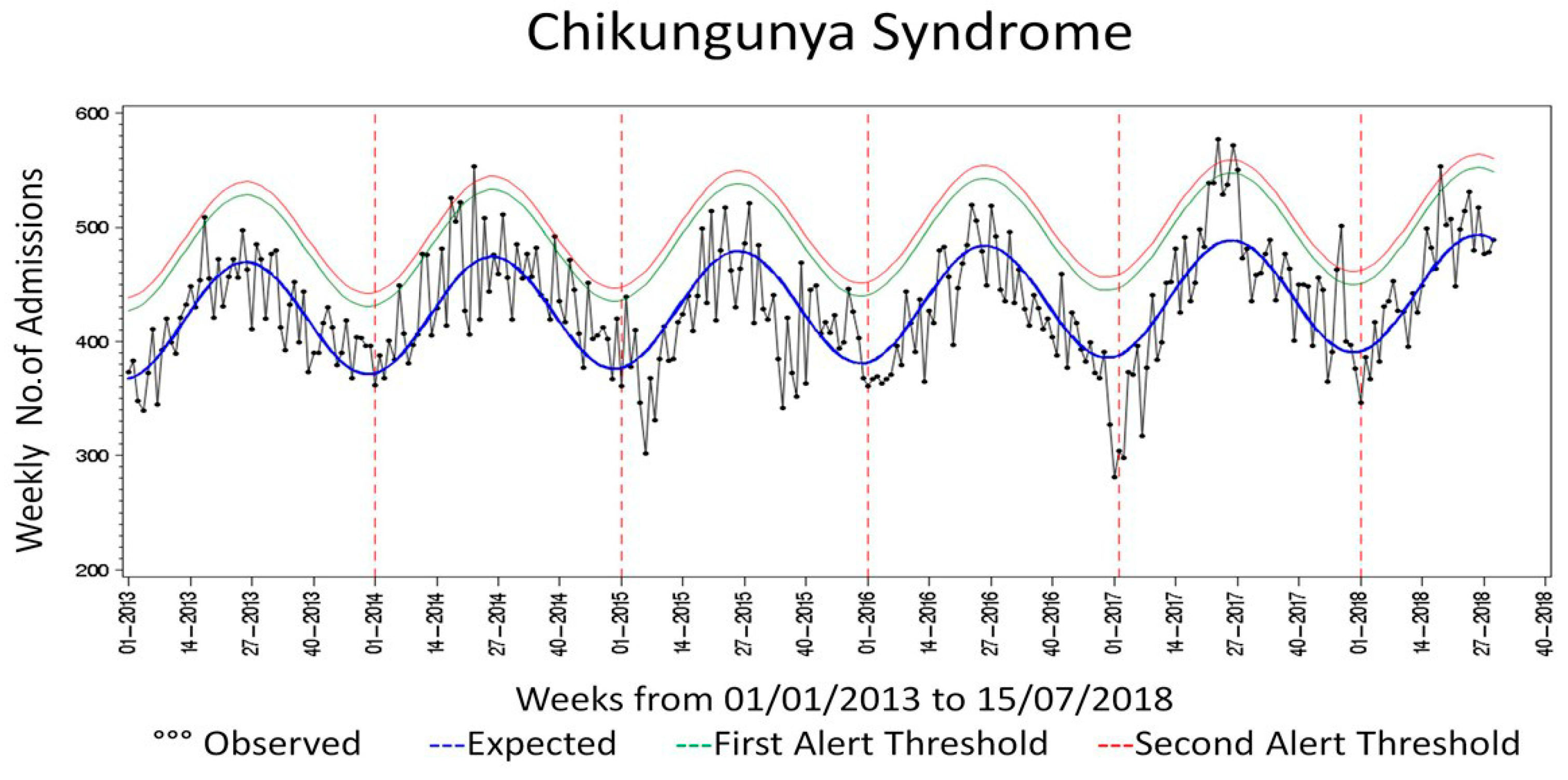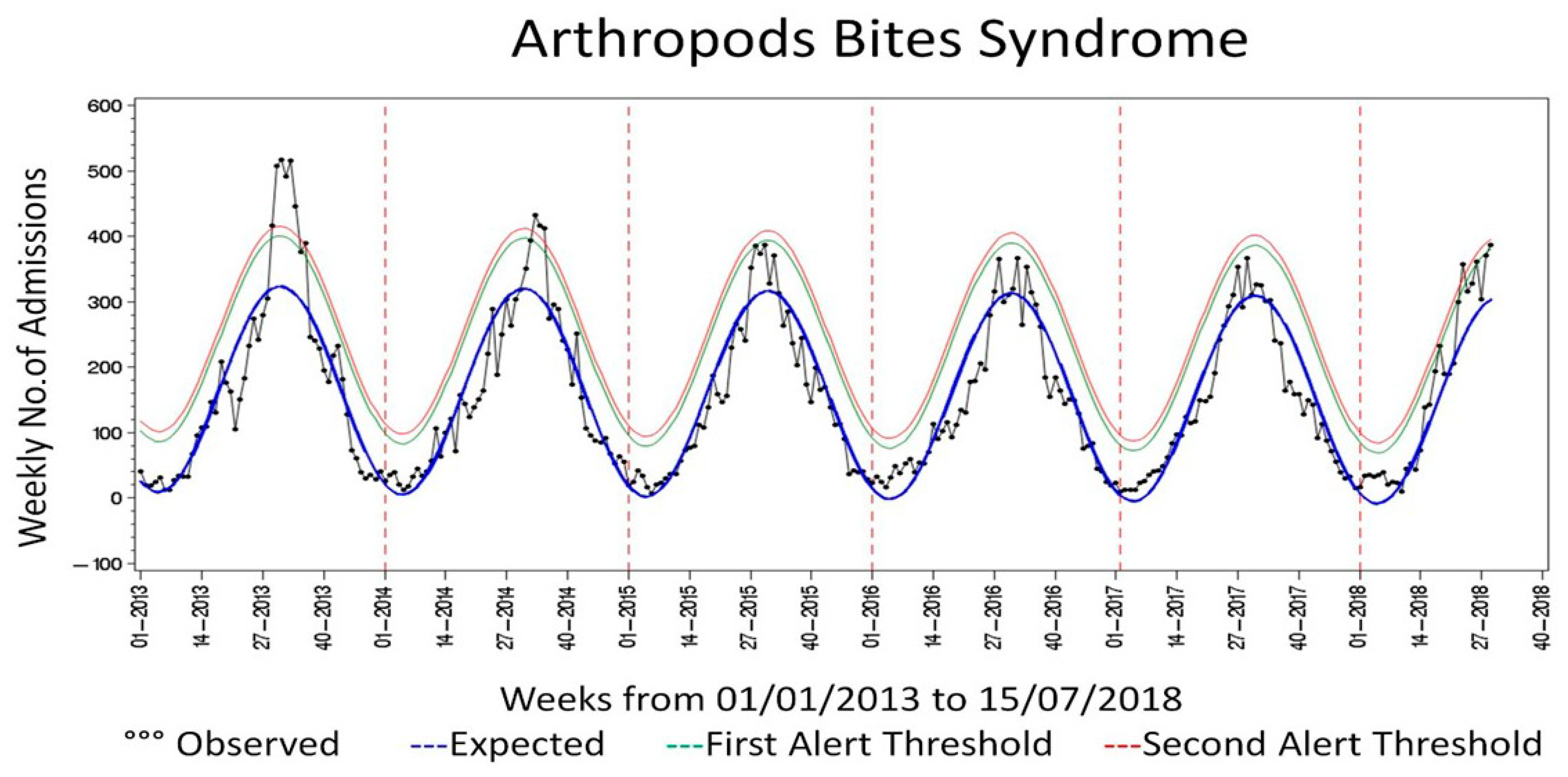The Surveillance of Chikungunya Virus in a Temperate Climate: Challenges and Possible Solutions from the Experience of Lazio Region, Italy
Abstract
1. Introduction
2. Passive Case Surveillance
3. Laboratory-Based Surveillance
4. Syndromic Surveillance
5. Non-Traditional Data Sources
6. Entomological Surveillance
7. Conclusions
Supplementary Materials
Author Contributions
Funding
Conflicts of Interest
References
- Ross, R.W. The Newala epidemic. III. The virus: Isolation, pathogenic properties and relationship to the epidemic. J. Hyg. 1956, 54, 177–191. [Google Scholar] [CrossRef] [PubMed]
- Diallo, M.; Thonnon, J.; Traore-Lamizana, M.; Fontenille, D. Vectors of CHIKV in Senegal: Current data and transmission cycles. Am. J. Trop. Med. Hyg. 1999, 60, 281–286. [Google Scholar] [CrossRef] [PubMed]
- Weaver, S.C.; Osorio, J.E.; Livengood, J.A.; Chen, R.; Stinchcomb, D.T. CHIKV and prospects for a vaccine. Expert Rev. Vaccines 2012, 11, 1087–1101. [Google Scholar] [CrossRef] [PubMed]
- Chretien, J.P.; Anyamba, A.; Bedno, S.A.; Breiman, R.F.; Sang, R.; Sergon, K.; Powers, A.M.; Onyango, C.O.; Small, J.; Tucker, C.J.; et al. Drought-associated chikungunya emergence along coastal East Africa. Am. J. Trop. Med. Hyg. 2007, 76, 405–407. [Google Scholar] [CrossRef] [PubMed]
- Kraemer, M.U.; Sinka, M.E.; Duda, K.A.; Mylne, A.Q.; Shearer, F.M.; Barker, C.M.; Barker, C.M.; Moore, C.G.; Carvalho, R.G.; Coelho, G.E.; et al. The global distribution of the arbovirus vectors Aedes aegypti and Ae. albopictus. Elife 2015, 4, e08347. [Google Scholar] [CrossRef] [PubMed]
- Pialoux, G.; Gauzere, B.A.; Jaureguiberry, S.; Strobel, M. Chikungunya, an epidemic arbovirosis. Lancet 2007, 7, 319–327. [Google Scholar] [CrossRef]
- Ng, L.C.; Hapuarachchi, H.C. Tracing the path of CHIKV—Evolution and adaptation. Infect. Genet. Evol. 2010, 10, 876–885. [Google Scholar] [CrossRef] [PubMed]
- Vazeille, M.; Moutailler, S.; Coudrier, D.; Rousseaux, C.; Khun, H.; Huerre, M.; Thiria, J.; Dehecq, J.; Fontenille, D.; Schuffenecker, I.; et al. Two Chikungunya isolates from the outbreak of La Reunion (Indian Ocean) exhibit different patterns of infection in the mosquito, Aedes albopictus. PLoS ONE 2007, 2, e1168. [Google Scholar] [CrossRef] [PubMed]
- Grandadam, M.; Caro, V.; Plumet, S.; Thiberge, J.M.; Souarès, Y.; Failloux, A.B.; Tolou, H.J.; Budelot, M.; Cosserat, D.; Leparc-Goffart, I.; et al. CHIKV, southeastern France. Emerg. Infect. Dis. 2011, 17, 910–913. [Google Scholar] [CrossRef] [PubMed]
- Delisle, E.; Rousseau, C.; Broche, B.; Leparc-Goffart, I.; L’Ambert, G.; Cochet, A.; Prat, C.; Foulongne, V.; Ferre, J.B.; Catelinois, O.; et al. Chikungunya outbreak in Montpellier, France, September to October 2014. Eurosurveillance 2015, 20, 21108. [Google Scholar] [CrossRef] [PubMed]
- Calba, C.; Guerbois-Galla, M.; Franke, F.; Jeannin, C.; Auzet-Caillaud, M.; Grard, G.; Pigaglio, L.; Decoppet, A.; Weicherding, J.; Savaill, M.C.; et al. Preliminary report of an autochthonous chikungunya outbreak in France, July to September 2017. Euro Surveill. 2017, 22. [Google Scholar] [CrossRef] [PubMed]
- Rezza, G.; Nicoletti, L.; Angelini, R.; Romi, R.; Finarelli, A.C.; Panning, M.; Cordioli, P.; Fortuna, C.; Magurano, F.; Silvi, G.; et al. Infection with CHIKV in Italy: An outbreak in a temperate region. Lancet 2007, 370, 1840–1846. [Google Scholar] [CrossRef]
- Bordi, L.; Carletti, F.; Lalle, E.; Colavita, F.; Meschi, S.; Di Caro, A.; Nicastri, E.; Scognamiglio, P.; Vairo, F.; Di Lallo, D.; et al. Molecular Characterization of Autochthonous Chikungunya Cluster in Lazio Region, Italy. Emerg. Infect. Dis. 2018, 24, 178–180. [Google Scholar] [CrossRef] [PubMed]
- Carletti, F.; Marsella, P.; Colavita, F.; Meschi, S.; Lalle, E.; Bordi, L.; Di Lallo, D.; Panella, V.; Di Caro, A.; Nicastri, E.; et al. Full-Length Genome Sequence of a CHIKV Isolate from the 2017 Autochthonous Outbreak, Lazio Region, Italy. Genome Announc. 2017, 5, e01306-17. [Google Scholar] [CrossRef] [PubMed]
- Venturi, G.; Di Luca, M.; Fortuna, C.; Remoli, M.E.; Riccardo, F.; Severini, F.; Toma, L.; Del Manso, M.; Benedetti, E.; Caporali, M.G.; et al. Detection of a chikungunya outbreak in Central Italy, August to September 2017. Euro Surveill. 2017, 22. [Google Scholar] [CrossRef] [PubMed]
- European Centre for Disease Prevention and Control (ECDC). Rapid Risk Assessment: Cluster of Autochthonous Chikungunya Cases in France (2017); ECDC: Stockholm, Sweden, 2017.
- Istituto Superiore di Sanità. Bulletin of Chikungunya Outbreak. 2018. Available online: www.salute.gov.it/portale/temi/documenti/chikungunya/bollettino_chikungunya_ULTIMO.pdf (accessed on 1 July 2018).
- Russo, G.; Caputo, B.; di Lascio, A.; Gatto, G.; Solimini, A.G. Awareness towards CHIKV infection risk by general practitioners in Rome: A questionnaire based survey before the 2017 outbreak. Infect. Dis. Trop. Med. 2018, 4, e451. [Google Scholar]
- Sambri, V.; Cavrini, F.; Rossini, G.; Pierro, A. MPLandini. The 2007 epidemic outbreak of CHIKV infection in the Romagna Region of Italy: A new perspective for the possible diffusion of tropical diseases in temperate areas? New Microbiol. 2008, 31, 303–304. [Google Scholar] [PubMed]
- Mardekian, S.K.; Roberts, A.L. Diagnostic options and challenges for dengue and CHIKVes. Biomed. Res. Int. 2015, 2015, 834371. [Google Scholar] [CrossRef] [PubMed]
- Henning, K.J. What is syndromic surveillance? MMWR Suppl. 2004, 53, 5–11. [Google Scholar] [PubMed]
- Reingold, A. If syndromic surveillance is the answer, what is the question? Biosecur. Bioterror. 2003, 1, 77–81. [Google Scholar] [CrossRef] [PubMed]
- Miner, J.J.; Aw-Yeang, H.X.; Fox, J.M.; Taffner, S.; Malkova, O.N.; Oh, S.T.; Kim, A.H.J.; Diamond, M.S.; Lenschow, D.J.; Yokoyama, W.M. Chikungunya viral arthritis in the United States: A mimic of seronegative rheumatoid arthritis. Arthritis Rheumatol. 2015, 67, 1214–1220. [Google Scholar] [CrossRef] [PubMed]
- Burt, F.J.; Chen, W.; Miner, J.J.; Lenschow, D.J.; Merits, A.; Schnettler, E.; Kohl, A.; Rudd, P.A.; Taylor, A.; Herrero, L.J.; et al. CHIKV: An update on the biology and pathogenesis of this emerging pathogen. Lancet Infect. Dis. 2017, 17, e107–e117. [Google Scholar] [CrossRef]
- Filia, A.; Bella, A.; Del Manso, M.; Baggieri, M.; Magurano, F.; Rota, M.C. Ongoing outbreak with well over 4,000 measles cases in Italy from January to end August 2017—What is making elimination so difficult? Euro Surveill. 2017, 22, 30614. [Google Scholar] [CrossRef] [PubMed]
- Brownstein, J.S.; Freifeld, C.C.; Madoff, L.C. Digital disease detection—Harnessing the Web for public health surveillance. N. Engl. J. Med. 2009, 360, 2153–2155, 2157. [Google Scholar] [CrossRef] [PubMed]
- Wilson, K.; Brownstein, J.S. Early detection of disease outbreaks using the Internet. Can. Med. Assoc. J. 2009, 180, 829–831. [Google Scholar] [CrossRef]
- Althouse, B.M.; Scarpino, S.V.; Meyers, L.A.; Ayers, J.W.; Bargsten, M.; Baumbach, J.; Brownstein, J.S.; Castro, L.; Clapham, H.; Cummings, D.A.; et al. Enhancing disease surveillance with novel data streams: Challenges and opportunities. EPJ Data Sci. 2015, 4, 17. [Google Scholar] [CrossRef] [PubMed]
- Eysenbach, G. Infodemiology: The epidemiology of (mis)information. Am. J. Med. 2002, 113, 763–765. [Google Scholar] [CrossRef]
- Chew, C.; Eysenbach, G. Pandemics in the age of Twitter: Content analysis of Tweets during the 2009 H1N1 outbreak. PLoS ONE 2010, 5, e14118. [Google Scholar] [CrossRef] [PubMed]
- Odlum, M.; Yoon, S. What can we learn about the Ebola outbreak from tweets? Am. J. Infect. Control 2015, 43, 563–571. [Google Scholar] [CrossRef] [PubMed]
- Gianfredi, V.; Bragazzi, N.L.; Nucci, D.; Martini, M.; Rosselli, R.; Minelli, L.; Moretti, M. Harnessing Big Data for Communicable Tropical and Sub-Tropical Disorders: Implications from a Systematic Review of the Literature. Front. Public Health 2018, 6, 90. [Google Scholar] [CrossRef] [PubMed]
- Oche, B.; Gaillard, B.; Léger, L.; Pélagie-Moutenda, R.; Sochacki, T.; Cazelles, B.; Ledrans, M.; Blateau, A.; Fontenille, D.; Etienne, M.; et al. An ecological and digital epidemiology analysis on the role of human behavior on the 2014 Chikungunya outbreak in Martinique. Sci. Rep. 2017, 7, 5967. [Google Scholar]
- Mahroum, N.; Adawi, M.; Sharif, K.; Waknin, R.; Mahagna, H.; Bisharat, B.; Mahamid, M.; Abu-Much, A.; Amital, H.; Luigi Bragazzi, N.; et al. Public reaction to Chikungunya outbreaks in Italy-Insights from an extensive novel data streams-based structural equation modeling analysis. PLoS ONE 2018, 13, e0197337. [Google Scholar] [CrossRef] [PubMed]
- Lounibos, L.P. Invasions by insect vectors of human disease. Annu. Rev. Entomol. 2002, 47, 233–266. [Google Scholar] [CrossRef] [PubMed]
- Paupy, C.; Delatte, H.; Bagny, L.; Corbel, V.; Fontenille, D. Aedes albopictus, an arbovirus vector: From the darkness to the light. Microbes Infect. 2009, 11, 1177–1185. [Google Scholar] [CrossRef] [PubMed]
- Sabatini, A.; Raineri, V.; Trovato, G.; Coluzzi, M. Aedes albopictus in Italia e possibile diffusione della specie nell’area mediterranea. Parassitologia 1990, 32, 30l–304. [Google Scholar]
- Dalla Pozza, G.L.; Romi, R.; Severini, C. Source and spread of Aedes albopictus in the Veneto Region of Italy. J. Am. Mosq. Control Assoc. 1994, 10, 589–592. [Google Scholar] [PubMed]
- Romi, R.; Toma, L.; Severini, F.; Di Luca, M. Twenty years of presence of Aedes albopictus in Italy: from the annoying pest mosquito to the real diseases vector. Eur. Infect. Dis. 2008, 2, 98–101. [Google Scholar]
- Fortuna, C.; Toma, L.; Remoli, M.E.; Amendola, A.; Severini, F.; Boccolini, D.; Romi, R.; Venturi, G.; Rezza, G.; Di Luca, M. Vector competence of Aedes albopictus for the Indian Ocean lineage (IOL) CHIKVes of the 2007 and 2017 outbreaks in Italy: A comparison between strains with and without the E1, A226V mutation. Euro Surveill. 2018, 23, 1800246. [Google Scholar] [CrossRef] [PubMed]
- Focks, D.A. A Review of Entomological Sampling Methods and Indicators for Dengue Vectors; World Health Organization: Geneva, Switzerland, 2003; Available online: http://apps.who.int/iris/bitstream/handle/10665/68575/TDR_IDE_DEN_03.1.pdf;jsessionid=242D8B6771035E21FAB8F835848DE8BA?sequence=1 (accessed on 15 July 2018).
- Diallo, M.; Dia, I.; Diallo, D.; Diagne, C.T.; Ba, Y.; Yactayo, S. Perspectives and Challenges in Entomological Risk Assessment and Vector Control of Chikungunya. J. Infect. Dis. 2016, 214 (Suppl. 5), S459–S465. [Google Scholar] [CrossRef] [PubMed]
- Runge-Ranzinger, S.; McCall, P.J.; Kroeger, A.; Horstick, O. Dengue disease surveillance: An updated systematic literature review. Trop. Med. Int. Health 2014, 19, 1116–1160. [Google Scholar] [CrossRef] [PubMed]
- Rosenberg, R.; Lindsey, N.P.; Fischer, M.; Gregory, C.J.; Hinckley, A.F.; Mead, P.S.; Paz-Bailey, G.; Waterman, S.H.; Drexler, N.A.; Kersh, G.J.; et al. Vital Signs: Trends in Reported Vectorborne Disease Cases—United States and Territories, 2004–2016. MMWR Morb. Mortal. Wkly. Rep. 2018, 67, 496–501. [Google Scholar] [CrossRef] [PubMed]
- Paty, M.C.; Six, C.; Charlet, F.; Heuzé, G.; Cochet, A.; Wiegandt, A.; Chappert, J.L.; Dejour-Salamanca, D.; Guinard, A.; Soler, P.; et al. Large number of imported chikungunya cases in mainland France, 2014, a challenge for surveillance and response. Euro Surveill. 2014, 19, 20856. [Google Scholar] [CrossRef] [PubMed]
- Sharp, T.M.; Ryff, K.R.; Alvarado, L.; Shieh, W.J.; Zaki, S.R.; Margolis, H.S.; Rivera-Garcia, B. Surveillance for Chikungunya and Dengue During the First Year of CHIKV Circulation in Puerto Rico. J. Infect. Dis. 2016, 214, S475–S481. [Google Scholar] [CrossRef] [PubMed]
- Newitt, S.; Elliot, A.J.; Morbey, R.; Durnall, H.; Pietzsch, M.E.; Medlock, J.M.; Leach, S.; Smith, G.E. The use of syndromic surveillance to monitor the incidence of arthropod bites requiring healthcare in England, 2000–2013.A retrospective ecological study. Epidemiol. Infect. 2016, 144, 2251–2259. [Google Scholar] [CrossRef] [PubMed]
- Regional Framework for Surveillance and Control of Invasive Mosquito Vectors and Re-emerging Vector-Borne Diseases 2014–2020. WHOEuro. Available online: http://www.euro.who.int/__data/assets/pdf_file/0004/197158/Regional-framework-for-surveillance-and-control-of-invasive-mosquito-vectors-and-re-emerging-vector-borne-diseases-20142020.pdf (accessed on 18 July 2018).


© 2018 by the authors. Licensee MDPI, Basel, Switzerland. This article is an open access article distributed under the terms and conditions of the Creative Commons Attribution (CC BY) license (http://creativecommons.org/licenses/by/4.0/).
Share and Cite
Vairo, F.; Di Pietrantonj, C.; Pasqualini, C.; Mammone, A.; Lanini, S.; Nicastri, E.; Castilletti, C.; Ferraro, F.; Di Bari, V.; Puro, V.; et al. The Surveillance of Chikungunya Virus in a Temperate Climate: Challenges and Possible Solutions from the Experience of Lazio Region, Italy. Viruses 2018, 10, 501. https://doi.org/10.3390/v10090501
Vairo F, Di Pietrantonj C, Pasqualini C, Mammone A, Lanini S, Nicastri E, Castilletti C, Ferraro F, Di Bari V, Puro V, et al. The Surveillance of Chikungunya Virus in a Temperate Climate: Challenges and Possible Solutions from the Experience of Lazio Region, Italy. Viruses. 2018; 10(9):501. https://doi.org/10.3390/v10090501
Chicago/Turabian StyleVairo, Francesco, Carlo Di Pietrantonj, Chiara Pasqualini, Alessia Mammone, Simone Lanini, Emanuele Nicastri, Concetta Castilletti, Federica Ferraro, Virginia Di Bari, Vincenzo Puro, and et al. 2018. "The Surveillance of Chikungunya Virus in a Temperate Climate: Challenges and Possible Solutions from the Experience of Lazio Region, Italy" Viruses 10, no. 9: 501. https://doi.org/10.3390/v10090501
APA StyleVairo, F., Di Pietrantonj, C., Pasqualini, C., Mammone, A., Lanini, S., Nicastri, E., Castilletti, C., Ferraro, F., Di Bari, V., Puro, V., Scognamiglio, P., Di Caro, A., Capobianchi, M. R., & Ippolito, G. (2018). The Surveillance of Chikungunya Virus in a Temperate Climate: Challenges and Possible Solutions from the Experience of Lazio Region, Italy. Viruses, 10(9), 501. https://doi.org/10.3390/v10090501






